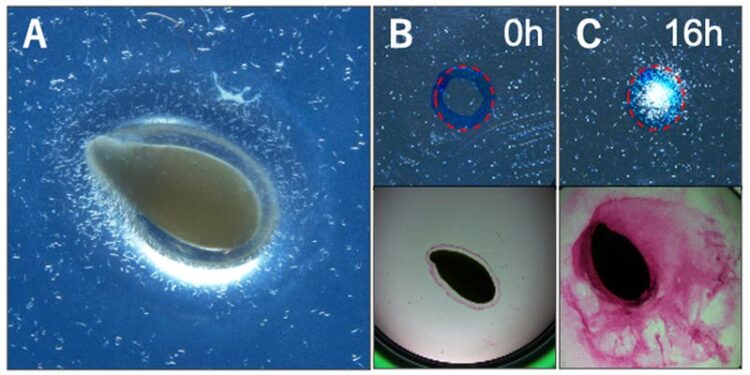Identification of plant-parasitic nematode attractant

A: Nematodes attracted to a flaxseed BC: (Top) Nematode attraction tests using seed exudate from 0 (B) and 16 (C) hours of imbibition. After imbibing for 16 hours, nematode attraction activity (white colony) was observed. BC: (Bottom) Staining test of seed cell wall components after 0 (B) and 16 (C) hours of imbibition. A large amount of cell wall components is released after 16 hours of imbibition.
Credit: Fig. 1 from (Tsai, A., et. al., Science Advances, 2021) under CC BY-NC 4.0 (https://creativecommons.org/licenses/by-nc/4.0/legalcode) / Edited: These images are parts of the original image selected for this press release.
A polysaccharide from flax seeds attracts crop-infecting nematodes.
A research collaboration based in Kumamoto University, Japan has become the first to successfully purify and identify an attractant for crop-infecting root-knot nematodes from flaxseeds. Their experiments revealed that rhamnogalacturonan-I (RG-I), a flaxseed cell wall component, can attract root-knot nematodes. The linkages between rhamnose and L-galactose are essential for the attraction.
Plant-parasitic nematodes are one of many known agricultural pests. They are parasites that infect plant roots and form feeding sites known as “root knots” to reproduce. Heavily-infested plants fail to absorb water and inorganic salts efficiently, which results in growth retardation or even death. Agricultural damage caused by nematodes has caused major concerns worldwide. The level of nematode-associated agricultural damage has been estimated to be several hundreds of billions of US dollars per year worldwide.
Current nematode treatment approaches, such as pesticides and soil fumigation, have been very effective in reducing crop damage since they aim to kill the nematodes directly in the soil. However, the cost of pesticides and soil fumigation has become a major financial burden for farmers. In addition, pesticides and fumigation may cause significant health and environmental damage, as pesticides are known to perturb the soil microbiome balance. Therefore, the development of environmentally-friendly nematode control approaches would be ideal.
Many attempts have been made to identify nematode attractants released by host plants without success. One of the reasons seems to be the inability to collect large quantities of root exudates to purify sufficient amounts of attractants for identification. Furthermore, the lack of large-scale nematode cultivation methods also limits the ability to perform attractant-screening assays.
The research collaboration at Kumamoto University has been working to identify nematode attractants as a means to develop nematode trapping devices. Previously, the research group successfully developed a method to cultivate nematodes under laboratory conditions. Recently, they discovered that flax seeds contain a novel nematode attractant. Flax seeds are readily available and can be grown in large quantities, making it an ideal source to purify the attractant. Now, using a series of chromatographic purification steps, the researchers successfully isolated a nematode attractant from flax seed exudates.
The research group examined the purified attractant and found that it consists of cell wall polysaccharides. Its structure was found to resemble rhamnogalacturonan-I with alternating rhamnose and galacturonic acid residues as the backbone, and galactose and fucose monomers as sidechains that decorate the RG backbone.
Further investigation revealed that the L-galactose sidechains are critical for nematode attraction. Interestingly, while D-galactose is commonly found in plant cell walls, L-galactose is comparatively rare, with flax seeds being an exceptionally good source. The researchers believe that the nematodes’ unique preference toward L-galactose suggests that they possess a sophisticated recognition mechanism capable of distinguishing small molecular differences of the attractant molecules. Researchers further confirmed that synthetic rhamnose-linked-L-galactose disaccharide is sufficient to attract nematodes. These sugars are likely not utilized as a source of nutrients for the nematodes, but strictly as an attractant.
“Using the nematode attractant discovered in our study, we are now one step closer to developing a functional nematode-trapping device,” said Professor Shinichiro Sawa, who led the study. “Since this attractant is a natural plant product and does not contain nematocidal agents, it may be able to bypass the pesticide registration process. Additionally, we believe that the nematode attractant from this research is unlikely to negatively impact the environment or human health, and has the potential to contribute to sustainable and environmentally-friendly agriculture. We look forward to our work inspiring novel innovations to the agricultural sector.”
Journal: Science Advances
DOI: 10.1126/sciadv.abh4182
Method of Research: Experimental study
Subject of Research: Animals
Article Title: Root-knot nematode chemotaxis is positively regulated by l-galactose sidechains of mucilage carbohydrate rhamnogalacturonan-I
Article Publication Date: 2-Jul-2021
COI Statement: The authors declare that they have no competing interests.
Media Contacts
Jason Sanderson
Kumamoto University
research-coordinator@jimu.kumamoto-u.ac.jp
Naoko Fukuda
Kumamoto University
research-coordinator@jimu.kumamoto-u.ac.jp
Office: 81-963-423-307
Original Source
https://ewww.kumamoto-u.ac.jp/en/news/480/
All latest news from the category: Life Sciences and Chemistry
Articles and reports from the Life Sciences and chemistry area deal with applied and basic research into modern biology, chemistry and human medicine.
Valuable information can be found on a range of life sciences fields including bacteriology, biochemistry, bionics, bioinformatics, biophysics, biotechnology, genetics, geobotany, human biology, marine biology, microbiology, molecular biology, cellular biology, zoology, bioinorganic chemistry, microchemistry and environmental chemistry.
Newest articles

First-of-its-kind study uses remote sensing to monitor plastic debris in rivers and lakes
Remote sensing creates a cost-effective solution to monitoring plastic pollution. A first-of-its-kind study from researchers at the University of Minnesota Twin Cities shows how remote sensing can help monitor and…

Laser-based artificial neuron mimics nerve cell functions at lightning speed
With a processing speed a billion times faster than nature, chip-based laser neuron could help advance AI tasks such as pattern recognition and sequence prediction. Researchers have developed a laser-based…

Optimising the processing of plastic waste
Just one look in the yellow bin reveals a colourful jumble of different types of plastic. However, the purer and more uniform plastic waste is, the easier it is to…



